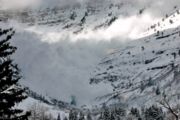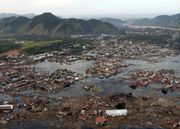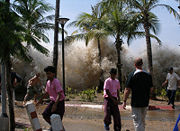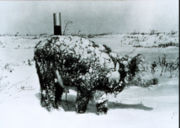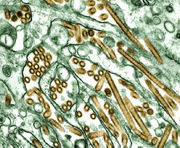Natural disaster
2008/9 Schools Wikipedia Selection. Related subjects: Geology and geophysics
A natural disaster is the consequence of a natural hazard (e.g. volcanic eruption, earthquake, or landslide) which affects human activities. Human vulnerability, exacerbated by the lack of planning or lack of appropriate emergency management, leads to financial, environmental or human losses. The resulting loss depends on the capacity of the population to support or resist the disaster, their resilience. This understanding is concentrated in the formulation: "disasters occur when hazards meet vulnerability". A natural hazard will hence never result in a natural disaster in areas without vulnerability, e.g. strong earthquakes in uninhabited areas. The term natural has consequently been disputed because the events simply are not hazards or disasters without human involvement.
Natural hazards
A natural hazard is a threat of an event that will have a negative effect on people or the environment. Many natural hazards are related, e.g. earthquakes can result in tsunamis, drought can lead directly to famine and disease. A concrete example of the division between hazard and disaster is that the 1906 San Francisco earthquake was a disaster, whereas earthquakes are a hazard. Hazards are consequently relating to a future occurrence and disasters to past or current occurrences.
Natural disasters
Land movement disasters
Avalanches
Notable avalanches include:
- The 1910 Wellington avalanche
- The 1954 Blons avalanches
- The 1970 Ancash earthquake
- The 1999 Galtür Avalanche
- The 2002 Kolka-Karmadon rock ice slide
Earthquakes
Some of the most significant earthquakes in recent times include:
- The 2004 Indian Ocean earthquake, the second largest earthquake in recorded history, registering a moment magnitude of 9.3. The huge tsunamis triggered by this earthquake cost the lives of at least 229,000 people.
- The 7.6-7.7 2005 Kashmir earthquake, which cost 79,000 lives in Pakistan.
- The 7.7 magnitude July 2006 Java earthquake, which also triggered tsunamis.
- The 7.9 magnitude May 12, 2008 Sichuan earthquake in Sichuan Province, China. Death toll at over 61,150 as of May 27, 2008.
- The 5.4 magnitude July29, 2008 Chino Hills Earthquake in Chino Hills, California.
Lahars
The Tangiwai disaster is an excellent example of a lahar, as is the one which killed an estimated 23,000 people in Armero, Colombia, during the 1985 eruption of Nevado del Ruiz.
Landslides and Mudflows
These occur with some regularity in parts of California after periods of heavy rain.
Volcanic eruptions
- An Eruption may in itself be a disaster, due to the explosion of the volcano or the fall of rock, but there are several effects that may happen after an eruption that are also hazardous to human life.
- Lava may be produced during the eruption of a volcano, a material consisting of superheated rock. There are several different forms, which may be either crumbly (like a`a) or gluey (like pahoehoe). Leaving the volcano, this destroys any buildings and plants it encounters.
- Volcanic ash - generally meaning the cooled ash - may form a cloud, and settle thickly in nearby locations. When mixed with water, this forms a concrete-like material. In sufficient quantity, ash may cause roofs to collapse under its weight, but even small quantities will cause ill-healtyh if inhaled. Since the ash has the consistency of ground glass, it causes abrasion damage to moving parts, such as engines.
- Supervolcanos : According to the Toba catastrophe theory, 70 to 75 thousand years ago, a super volcanic event at Lake Toba reduced the human population to 10,000 or even 1,000 breeding pairs, creating a bottleneck in human evolution. The main danger from a supervolcano is the immense cloud of ash, which has a disastrous global effect on climate and temperature for many years.
- Pyroclastic flows consist of a cloud of hot volcanic ash which builds up in the air above a volcano, until it collapses under its own weight, and streams very rapidly from the mountain, burning anything in its path. It is believed that Pompeii was destroyed by a pyroclastic flow.
- Lahars, mentioned above, may be triggered by volcanic eruptions.
Water disasters
Floods
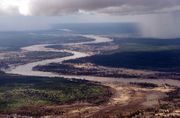
Some of the most notable floods include:
- The Huang He (Yellow River) in China floods particularly often. The Great Flood of 1931 caused between 800,000 and 4,000,000 deaths.
- The Great Flood of 1993 was one of the most costly floods in US history.
- The 1998 Yangtze River Floods, also in China, left 14 million people homeless.
- The 2000 Mozambique flood covered much of the country for three weeks, resulting in thousands of deaths, and leaving the country devastated for years afterward.
Tropical cyclones can result in extensive flooding and storm surge, as happened with:
- Bhola Cyclone, striking East Pakistan (now Bangladesh) in 1970,
- Typhoon Nina, striking China in 1975,
- Tropical Storm Allison, which struck Houston, Texas in 2001 and
- Hurricane Katrina, which left most of New Orleans under water in the year 2005.
Limnic eruptions
A limnic eruption occurs when CO2 suddenly erupts from deep lake water, posing the threat of suffocating wildlife, livestock and humans. Such an eruption may also cause tsunamis in the lake as the rising CO2 displaces water. Scientists believe landslides, volcanic activity, or explosions can trigger such an eruption.To date, only two limnic eruptions have been observed and recorded:
- In 1984, in Cameroon, a limnic eruption in Lake Monoun caused the deaths of 37 nearby residents
- At nearby Lake Nyos in 1986 a much larger eruption killed between 1,700 and 1,800 people by asphyxiation.
Tsunamis
Tsunami can be caused by undersea earthquakes as the one caused in Ao Nang, Thailand by the 2004 Indian Ocean Earthquake, or by landslides such as the one which occurred at Lituya Bay, Alaska in.
- Ao Nang, Thailand (2004). The 2004 Indian Ocean Earthquake created the tsunami and disaster at this site.
- Lituya Bay, Alaska (1953). See paragraph three (3) of the entry. A mega-tsunami occurred here, the largest ever recorded.
This would also fit within Land movement category because it starts with an earthquake.
Weather disasters
Blizzards
Significant blizzards in the United States include:
- The Great Blizzard of 1888
- The Schoolhouse Blizzard earlier the same year
- The Armistice Day Blizzard in 1940
- The Storm of the Century in 1993
Droughts
Well-known historical droughts include:
- 1900 India, killing between 250,000 and 3.25 million.
- 1921-22, Soviet Union, in which over 5 million perished from starvation due to drought.
- 1928-30, northwest China, resulting in over 3 million deaths by famine.
- 1936 and 1941, Sichuan Province, China, resulting in 5 million and 2.5 million deaths respectively.
- As of 2006, Western Australia, New South Wales, Victoria and Queensland (states of Australia) have been under drought conditions for five to ten years. The drought is beginning to affect urban populations for the first time.
- In 2006, Sichuan Province, China experienced its worst drought in modern times, with nearly 8 million people and over 7 million cattle facing water shortages.
Hailstorms
A particularly damaging hailstorm hit Munich, Germany on August 31, 1986, felling thousands of trees and causing millions of dollars in insurance claims.
Heat waves
The worst heat wave in recent history was the European Heat Wave of 2003.
Cyclonic storms
Hurricane, tropical cyclone, and typhoon' are different names for the same phenomenon: a cyclonic storm system that forms over the oceans. The deadliest hurricane ever was the 1970 Bhola cyclone; the deadliest Atlantic hurricane was the Great Hurricane of 1780, which devastated Martinique, St. Eustatius and Barbados. Another notable hurricane is Hurricane Katrina, which devastated the Gulf Coast of the United States in 2005.
Fire
Wildfires are an uncontrolled fire burning in wildland areas. Common causes include lightning and drought but wildfires may also be started by human negligence or arson. They can be a threat to those in rural areas and also wildlife.
Health and disease
Epidemic
An epidemic is an outbreak of a contractible disease that spreads at a rapid rate through a human population. A pandemic is an epidemic whose spread is global. There have been many epidemics throughout history, such as Black Death. In the last hundred years, significant pandemics include:
- The 1918 Spanish flu pandemic, killing an estimated 50 million people worldwide
- The 1957-58 Asian flu pandemic, which killed an estimated 1 million people
- The 1968-69 Hong Kong flu pandemic
- The 2002-3 SARS pandemic
- The AIDS epidemic, beginning in 1959
Other diseases that spread more slowly, but are still considered to be global health emergencies by the WHO include:
- XDR TB, a strain of tuberculosis that is extensively resistant to drug treatments
- Malaria, which kills an estimated 1.5 million people each year
- Ebola hemorrhagic fever, which has claimed hundreds of victims in Africa in several outbreaks
Famine
In modern times, famine has hit Sub-Saharan Africa the hardest, although the number of victims of modern famines is much smaller than the number of people killed by the Asian famines of the 20th century.
Space
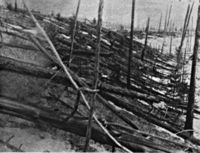
Impact events
One of the largest impact events in modern times was the Tunguska event in June, 1908.
Solar flare
A solar flare is a phenomenon where the sun suddenly releases a great amount of solar radiation, much more than normal. Some known solar flares include:
- An X20 event on August 16, 1989
- A similar flare on April 2, 2001
- The most powerful flare ever recorded, on November 4, 2003, estimated at between X40 and X45
- The most powerful flare in the past 500 years is believed to have occurred in September 1859
This is not currently a natural disaster because it has not damaged human structures; however, it does have the potential to be a natural disaster as we continue to explore space.
